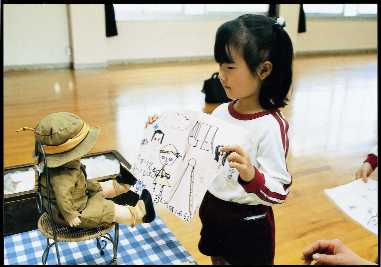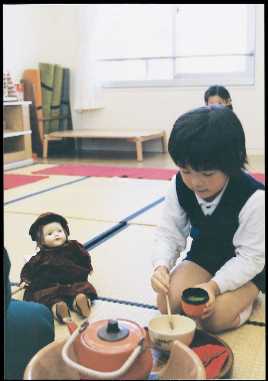|
|

|

|
Two children draw dolls on front
of
postcards to be sent to children in Japan
|

|
Although people of all ages visited the 2002
Friendship Doll Exhibit at the Japanese American National Museum in Los
Angeles, the children especially enjoyed the special activities planned for them by the museum staff. About 15 Friendship Dolls, both American and
Japanese, were exhibited at the museum in two large special exhibition rooms
from July to October 2002. Most of these dolls were from the original doll
exchange between the U.S. and Japan that took place in 1927, but there were
also a few more recent Friendship Dolls. Before
the children walked into the two large exhibition rooms, they could pick up a
passport and get an entry stamp. On the front of the passport, children could
complete personal information and draw a self-portrait. The inside of the
passport provided space for children to draw a picture of a favorite doll and
complete the following questions about the doll:
- What is his/her name?
- Where does s/he live now?
- What is s/he wearing?
- Why is this your favorite doll?
As
children went through the galleries, they were encouraged to consider the
meaning of the Friendship Dolls by answering the following questions printed
on the inside of the passport:
- In 1927, how did the Japanese and American
children make new friends?
- What interesting things have your friends
taught you about their cultures? For example, about food, holidays, a new
word in a different language, . . .
- What have you taught your friends about your
own culture?
|
|
|
|

|

|
Japanese schoolgirl shows
Juliette
the picture she drew for her
One of photos on display at Doll Exhibit
at Japanese American National Museum
|
|
|
The
Friendship Doll exhibition rooms had three special areas where children could
participate in various activities. As children entered the exhibition area,
they could go to a corner to find out more about the Friendship Dolls.
Children could open plastic boxes filled with all kinds of educational
material on the following subjects:
- Dolls, Dolls, Dolls
- Sidney L. Gulick
- The Truth About the Blue-eyed Doll Song
- Happy Hina Matsuri (Doll Festival)
- What Can I Do?
- Got Passport?
- Doll Detectives
- November 1927 (month Japanese dolls arrived
in America)
Children
could also listen to a CD of the "Blue-eyed Doll" song. The
activity corner also contained a comment book, 1927 photographs, two hina
doll sets, replicas of 1927 U.S. and Japan passports, and a large illustrated
book entitled Mary, the Blue-eyed Doll by children's author Eiko Takeda. After
taking a look at the Japanese and American Friendship Dolls, young children
could then go to another corner with three large boxes packed with all sorts
of interesting Japanese and American items, including several dolls. The
following instructions were posted:
Work with a partner and pack a suitcase to
"send" to a new friend who lives far away. 1.
Look at the map and choose a place where you would like to make a new
friend.
2. Pack a suitcase to "send" to your new friend. Include a doll
and a few things the doll will need (food, books).
3. How did you decide what to pack?
4. Write a message to your new friends on a sticky note. Place the sticky
note on the map where you would like to "send" your suitcase.
Several of the notes contained cute messages
from the children, including the following one:
Hi! My name is Erika Bravo Ramirez. Did you
know something? I wish I could have a friend from your country. I wish I
could talk your language. That is my dream. I wish too I could visit your
country. Thank you!
|
|
|
|

|

|
Traditional Japanese tea
ceremony for Rosemary
One of photos on display at
Doll Exhibit at Japanese
American National Museum
|
|
|
As
a final activity, children were encouraged to write a letter to a friend in
Japan. Postcards were provided on a table, and the front of each postcard had
an outline of a small boy or girl. Children could add features and color to
the outline. These letters were sent to the elementary and preschool children
at the schools in Hyogo Prefecture and Osaka that loaned their 75-year-old
American Friendship Dolls for the special exhibition at the Japanese American
National Museum. "Like those written in 1927 as part of the original
Friendship Doll exchange, the children's letters tell of their lives in
America and their desires to learn about other cultures."After
the exhibition, the Japanese American National Museum sent new Friendship
Dolls to the children of Japan as a thank-you gesture for lending the museum
their dolls. Allyson Nakamoto, Head of the Educational Components Department
at the museum, explains about the dolls to be sent:
One of these dolls, Maria, was sent to us by
Dr. Sidney Gulick, 3d, and his wife, Dr. Frances Gulick. Maria and the six
dolls chosen by the National Museum show the diversity of the United States
not only in ethnicity, but also in vocation. For example, we are sending an
African American veterinarian, an Asian American girl, and a European
American soccer player. It is our hope that these dolls capture the hearts
and midst of the Japanese children, just like their 1927 predecessors.
The staff at the Japanese
American National Museum did a fine job in getting children interested and
involved in the Friendship Doll exhibit. Some younger children may get the
details of the Friendship Doll story a little confused, such as the boy who
commented about the "Japanese doll from China," but they all were
encouraged to make friends with people from around the world.
|


